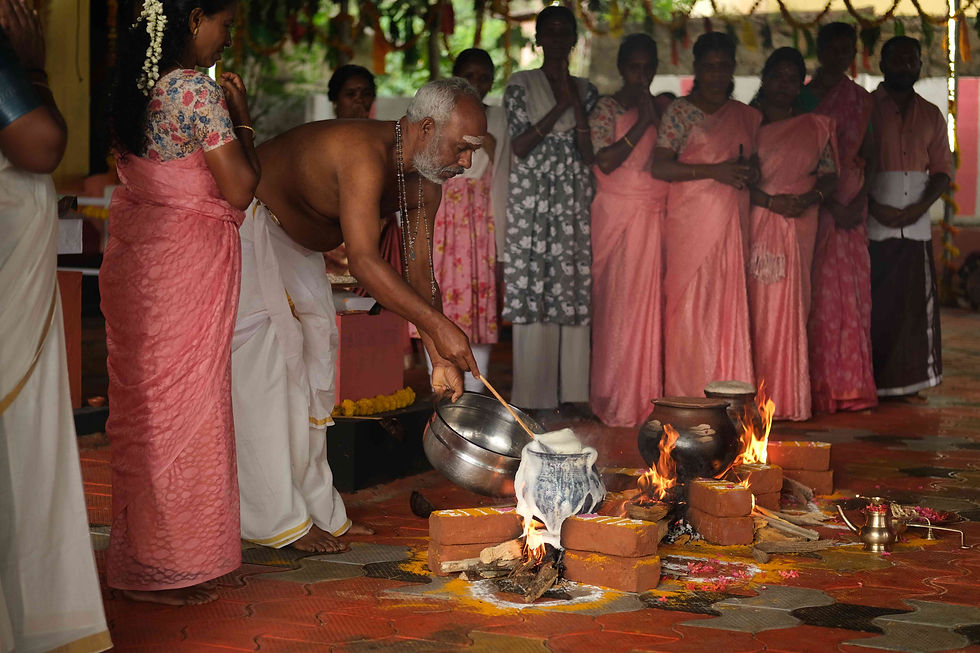Paliya Ulsavam at Kumaly: Celebrating Palichiyamma
- Vysakh Seluraj
- Aug 29
- 4 min read
Paliya Ulsavam is the annual festival of the Paliyar community in Kerala, held every April during the harvest season. Traditionally, it was deeply tied to the agricultural cycle, offering thanks to the community’s deities for protection from harm and seeking blessings for the future. What began as a forest-based celebration with gatherings, feasts, dances around sacred trees and ritual fires has evolved into temple-centred worship that blends traditional practices with structured rituals.
WATCH NOW: Episode on Paliya Ulsavam at Kumily
Palichiyamma Temple and Origins
The community’s faith centers around Palichiyamma, their clan deity, worshipped alongside Karuppuswamy at Kumily. Dedicated families are entrusted with rituals for each deity. Initially, worship was conducted beneath a large banyan tree. Plans to build a temple for Palichiyamma faced delays due to lack of funds, until an unexpected turn of events reshaped community resolve.
Years ago, the sudden death of the then temple secretary and a following thunderstorm the very next day, the incident was seen as an omen. The community came together, continued the construction, and completed it with public support, this time observing Brahmanical rituals.
Aruvi, chieftain from Kumily settlement, recalls, “The word Paliyar itself originates from Palichiyammayude Makkal, meaning children of Goddess Palichiyamma.”
The Forest Pilgrimage
One of the most unique aspects of the festival is the ritualistic journey to Kalluvariyar, a forest site about 15 km from Thekkady. A week before the festival, the community embarks on a three-day trek to collect sacred water and soil from the ancestral shrine at Kalluvariyar.
According to belief, women carry nine pots of water from Kalluvariyar, while men accompany them for protection. This water is used for rituals and sprinkled along the village boundaries as protection against disease and misfortune. A small amount of soil is also brought back, symbolising the presence of Palichiyamma at the festival.
The procession is deeply symbolic: women carrying the sacred water represent Palichiyamma’s journey to the settlement, while male family members of Karuppuswamy walk ahead in trance, signifying the deity’s role in protecting her path.

Rituals of Preparation
On returning to the village, the deities are prepared with abhishekam using the sacred water. The next day, the Kodiyettam (flag hoisting) signals the start of a seven-day observance period, during which the community maintains strict vows. Both men and women follow a vegetarian diet, practice celibacy, and sleep in separate accommodations. Before Kodiyettam, Karuppuswamy is invited to the temple from his abode through a ceremony, and his presence and blessings are sought.
Women also begin preparations for the Mulapayaru ritual, sprouting seeds of millet, corn, and lentils in carefully shaded areas of the temple. This sprouting is considered a direct reflection of divine blessings: healthy growth signifies favour, while wilting sprouts are seen as a result of lapses in vows. Each evening, women perform Kummi-adi, a devotional dance around the mulapayaru, believed to aid its growth.

The Main Festival
After a week of vows, the main festival unfolds over three days. Devotees perform a variety of votive rituals and offerings, each carrying deep spiritual meaning:
Mulapayaru – Millet and other seeds are sprouted in a specially arranged supporting structure using clay pots, supported by coir, wood, or steel frames, and decorated in symbolic arrangements. Devotees observe strict vows during the sprouting period, and the health of the sprouts is interpreted as an indicator of divine favour. Sprouts that wither or fail are understood as consequences of lapses in ritual observance, requiring the devotee to renew their vows and offerings in the following year.
Maavilakku & Amman Vilakku – This offering consists of a lamp placed on a pot, covered with a paste made of flour. Devotees must maintain ritual purity during the vow period; any disruption is believed to manifest during the ritual, such as the lamp failing to remain lit or the pot becoming difficult to carry. A similar offering that includes a goddess image and flowers is called Amman Vilakku.
Theechatti – This is a votive ritual performed for protection against illnesses such as smallpox and measles. Special clay pots, often sourced from Tamil Nadu, are filled with ingredients such as camphor, neem leaves, and frankincense, and then ignited. Devotees carry these flaming pots as a demonstration of devotion and faith. Restrictions apply to this offering: families that have experienced a recent bereavement or are under social sanctions within the community are prohibited from participating. If these prohibitions are violated, it is believed that the flames will not ignite properly, requiring further ritual resolution.
Kavadi, Swamy Thulluka, Shoolamkuthal, and Pongala – Other votive acts performed by devotees as fulfilment of vows.
Photos: People participating in various rituals during the Paliya Ulsavam
Paliya Nritham: The Sacred Dance of the Community
An integral part of the festival is the Paliya Nritham, the traditional dance of the Paliyar community. Performed during festive nights, this dance embodies both celebration and devotion. Paliya Nritham is a collective performance by both men and women, often accompanied by rhythmic songs, hand-clapping, and the beating of traditional instruments.
Culmination in Celebration
On the final day, Pongal is celebrated, marking both the completion of the festival and the community’s renewed bond with their deities. Upon the completion of the festival, Goddess Palichiyamma is taken back to Kalluvariyar, with a promise to meet next year.























Comments